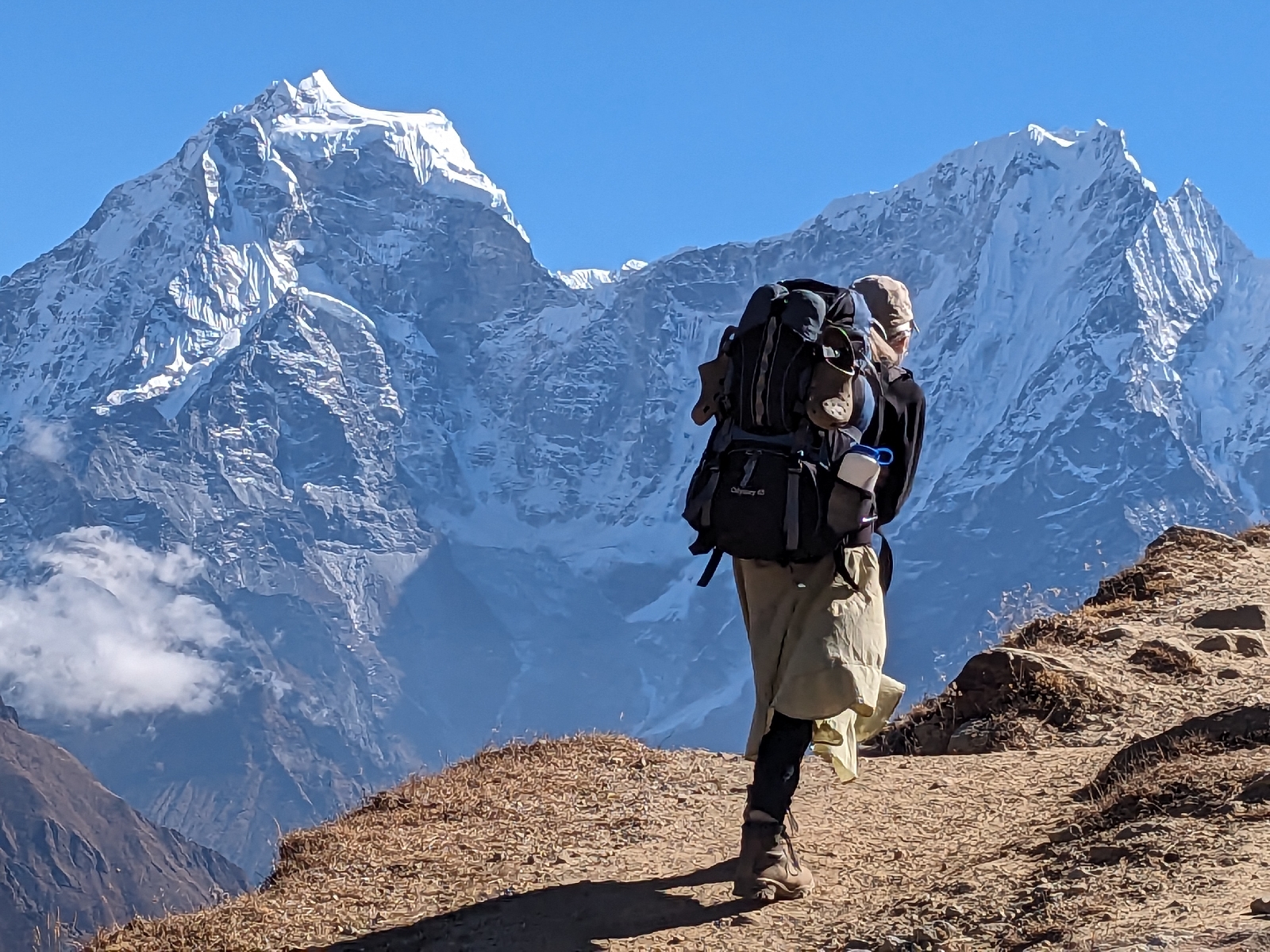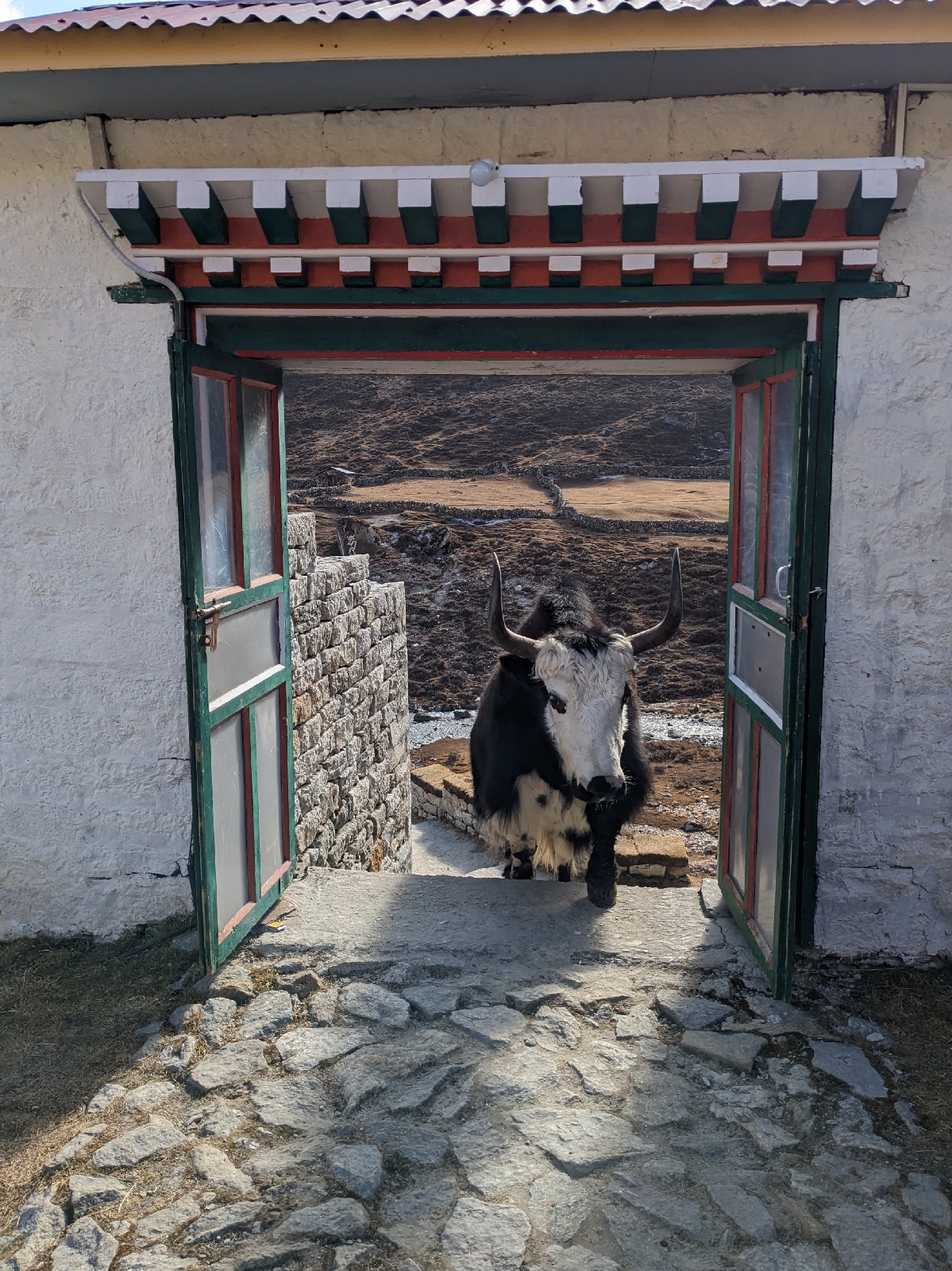Great title, huh? I WAS going to title this post "Into Thin Air," but then, someone already used that name and made millions of dollars. That could have been me! But in a flash of brilliance, I came up with something even better: "Into the Land of the Yak Dung Fires"! Ol' J.K. could have used that tack as well and titled his book, even more descriptively, "ABOVE the Land of the Yak Dung Fires" - after all, their mission was to Boldly Go Where No Yak Has Gone Before. Yak lovers around the world would have snatched up the book!
And while we're on the subject of yaks, we are truly in the country of the yaks (and yak dung fires). The creatures we've called yaks down lower are mostly dzopkyos, a mix between yaks and Tibetan cows. (These names - yaks, dzopkyos - are the males, females have other names - so you never eat yak cheese, you eat NAK cheese!) Yaks are huge, shaggy, insulated, move-aside-for-nothing creatures that are extremely CUTE! One morning behind our teahouse was a herd of yaks, all with frosted backs. Brrrrr! And they leave behind a lot of good fuel for burning. The yak dung fires pervade the teahouse, and the whole area, with their particular acrid (but not unpleasant) smell. Does make the eyes burn a bit.
Yes, it's COLD here in Yak Dung Fire Land. (Nothing is heated except the tea room for a few hours at night - yay yak dung fires!) And there's basically no air. And you have to choose whether to walk or talk, definitely no walk AND talk! As Walter Mitty said (in that fabulous movie) while climbing in the Himalayas: "I have to make oxygen choices."
Over the past weeks we've plodded our way up and down and up and up, higher than Mt. Rainier, higher than Yertle's pile of turtles, higher than low earth orbit - oh, sorry, getting a little carried away here, and yet, there are still these peaks WAY above us. We just spent five days in Gokyo, a little village at 15,600 feet, on the edge of a sacred lake whose color is a brilliant, sparkling turquoise, a stunning spot. (The Gokyo Valley is one of the side valleys off the Everest Base Camp route.) We climbed to 17,700 ft. Renjo La (la means pass) where we could see Everest, Lhotse, Makalu, Nuptse, and more. And Cho Oyu (6th highest mountain in the world) was right up the valley, in fact right out our room window!
A sign in one of our teahouse rooms, on our way upwards, said (among other points): "Please kindly show your positive attitude in altitude." I guess altitude, besides making it hard to breathe, or giving you AMS or HAPE or HACE, or killing you, can also make you cranky. Which I NEVER am. Just ask Marc. Actually, we've been feeling fairly chipper up here, in our hypoxic state. Every now and then you just have to breathe fast to catch up. Like after strenuous activities such as brushing your teeth, or rolling over in bed.
Important questions often on our minds these days:
When will the yak dung fire be lit? How much will they stoke it? Will they give us seconds on dal bhat? How much dal bhat can I eat? How long can I lie beneath my quilt before I have to get up and pee in the icy darkness? Is that trekker's hack contagious? What's our elevation? Dal bhat is HOW MUCH now? Asian toilet or western toilet? Will the western toilet have a seat? A tank? Did I bring enough warm clothes? (The answer, definitely yes. I look like the Pilsbury Doughboy.)
And observations:
Look, a yak! Look, a musk deer. Look, a Himalayan pika. Look, HOOKS in our room! Look, humongous, gigantic, immense, massive, spectacular, ice covered, sheer mountains. They ARE BIG. Really big. And they continue to be mind bogglingly mind boggling!
The area we're hiking through is mainly Tibetan Buddhist. One of our teahouse hosts, Daschi, spent time with us one morning telling about the beliefs and traditions. He was so sweet and earnest and knowledgeable (he looked to be about 20, but really I have no idea). He had been playing music we recognized - a beautiful chant that every shop in Namche played constantly 14 years ago (so much so that we bought the CD, and just last year when I heard it in a little Tibetan shop at the Pike Place Market in Seattle, I just felt good).
Anyway, the chant. Om mani padme hum. Daschi told us a LOT about it, but what I remember is that it's a chant for peace and goodness for all beings, so it brings kindness and goodness. He talked about one of the deities with "kindness eyes" (nice image, huh?). The incence burner he swings around the lodge every morning and evening (again, his explanation was very detailed) basically cleanses wherever the smoke goes - chases away bad things and makes it clear/clean.
He said beauty is important. And kindness. In a world that is often hard.
He said that "you should always try to bring happiness to others, and if you can't bring happiness, do not bring sadness."
He also gave us a gift of an orange. We were very touched.
We've met so many interesting people, both foreign trekkers, and Nepali teahouse hosts. And a few amazing guides from some small trekking groups (the large groups tend to mostly interact with themselves). So many different and unique accents. So many different cultures and experiences and ideas.
So we've mananged to survive yaks, mules, ponies, stairs, suspension bridges, cold, wind, sun, rain, other trekkers, rocks, rocks, rocks, language barriers, in good health and happy. We are truly grateful.








No comments:
Post a Comment